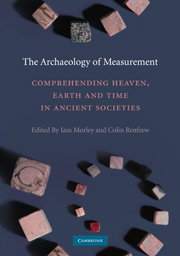Book contents
- Frontmatter
- Contents
- List of figures and tables
- List of contributors
- Acknowledgements
- The Archaeology of Measurement
- Introduction: Measure: Towards the construction of our world
- SECTION I NUMBER: COUNTING, MATHEMATICS AND MEASURE
- SECTION II MATERIALISING THE ECONOMY
- SECTION III DIMENSIONS AND BELIEF
- 10 Architectural measurements in the Indus cities: The case study of Mohenjo-Daro
- 11 Teotihuacan city layout as a cosmogram: Preliminary results of the 2007 Measurement Unit Study
- 12 Aztec dimensions of holiness
- 13 Establishing direction in early Egyptian burials and monumental architecture: Measurement and the spatial link with the ‘other’
- SECTION IV CALENDAR AND COSMOLOGY
- SECTION V THE SPIRITUALITY OF MEASURE
- Index
- References
11 - Teotihuacan city layout as a cosmogram: Preliminary results of the 2007 Measurement Unit Study
Published online by Cambridge University Press: 05 June 2012
- Frontmatter
- Contents
- List of figures and tables
- List of contributors
- Acknowledgements
- The Archaeology of Measurement
- Introduction: Measure: Towards the construction of our world
- SECTION I NUMBER: COUNTING, MATHEMATICS AND MEASURE
- SECTION II MATERIALISING THE ECONOMY
- SECTION III DIMENSIONS AND BELIEF
- 10 Architectural measurements in the Indus cities: The case study of Mohenjo-Daro
- 11 Teotihuacan city layout as a cosmogram: Preliminary results of the 2007 Measurement Unit Study
- 12 Aztec dimensions of holiness
- 13 Establishing direction in early Egyptian burials and monumental architecture: Measurement and the spatial link with the ‘other’
- SECTION IV CALENDAR AND COSMOLOGY
- SECTION V THE SPIRITUALITY OF MEASURE
- Index
- References
Summary
Introduction
Teotihuacan, an ancient and highly planned city in the Mexican Highland, has been the focus of varied archaeological inquiries. Those related to its genesis, including the causal factors behind the foundation of such a populous city at this particular location, are of concern not only to Mesoamericanists, but also to those who pursue general themes related to state formation, preindustrial urbanism, or the evolution of human cognitive systems. Ideological factors and an innovative system of urban planning were formulated and applied on a grand scale at Teotihuacan, as is suggested by its unique city layout, unprecedented monumental architecture, and consistent spatial orientations. Here I discuss an indigenous measuring system that the Teotihuacanos could have used to create their precise city layout and major constructions. With newly available data I identify a measurement unit used in Teotihuacan. I present my preliminary interpretations of the ideological principles underlying Teotihuacan's urban arrangement and suggest how the ruling groups of this city conceived their world in time and space and materialized their worldview in city planning. Teotihuacan is a source of exceptionally comprehensive data relevant to better understanding the cognitive structures of ancient Mesoamerican societies, compiled through the extensive excavation and consolidation of the city's major monuments, which are maintained for our benefit by the Mexican National Institute of Anthropology and History (INAH).
- Type
- Chapter
- Information
- The Archaeology of MeasurementComprehending Heaven, Earth and Time in Ancient Societies, pp. 130 - 149Publisher: Cambridge University PressPrint publication year: 2010
References
- 13
- Cited by

